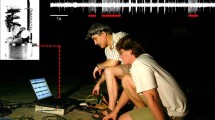Abstract
We report the results of a search for evidence of periodic unstableorbits in the electroreceptors of the catfish. The function of thesereceptor organs is to sense weak external electric fields. Inaddition, they respond to the ambient temperature and to the ioniccomposition of the water. These quantities are encoded by receptorsthat make use of an internal oscillator operating at the level of themembrane potential. If such oscillators have three or more degreesof freedom, and at least one of which also exhibits a nonlinearity,they are potentially capable of chaotic dynamics. By detecting theexistence of stable and unstable periodic orbits, we demonstratebifurcations between noisy stable and chaotic behavior using theambient temperature as a parameter. We suggest that the techniquedeveloped herein be regarded as an additional tool for the analysisof data in sensory biology and thus can be potentially useful instudies of functional responses to external stimuli. We speculatethat the appearance of unstable orbits may be indicative of a stateof heightened sensory awareness by the animal.
Similar content being viewed by others
References
Artuso R, Aurell E, Cvitanovic P (1990a) Recycling of strange sets I: Cycle expansions. Nonlinearity3:325–338.
Artuso R, Aurell E, Cvitanovic P (1990b) Recycling of strange sets II: Applications. Nonlinearity3:361–375.
Bevington PR (1969) Data Reduction and Error Analysis. McGraw-Hill, New York. pp. 48–49.
Braun HA, Wissing H, Schäfer K, Hirsch MC(1994) Oscillation and noise determine signal transduction in shark multimodal sensory cells. Nature367:270–273.
Chang T, Schiff SJ, Sauer T, Gossard J-P, Burke RE (1994) Stochastic versus deterministic variability in simple neuronal circuits. I. Monosynaptic and spinal cord reflexes. Biophys. J.67:671–683.
Christini DJ, Collins JJ (1995) Controlling nonchaotic neuronal noise using chaos control techniques. Phys. Rev. Lett.75:2782–2785.
Cvitanovic P (1988) Invariant measurement of strange sets in terms of cycles. Phys. Rev. Lett.61:2729–2732.
Cvitanovic P (1991) Periodic orbits as the skeleton of classical and quantum chaos. Physica D51:138–152.
Ditto WL, Rauseo SN, Spano ML (1990) Experimental control of chaos. Phys. Rev. Lett.65:3211–3214.
Ditto W, Pecora L (1993) Mastering chaos. Scientific American (August):78–84.
Garfinkel A, Spano ML, Ditto WL, Weiss JN (1992) Controlling cardiac chaos. Science257:1230–1235.
Goldberger A, Rigney A, West BJ (1990) Chaos and fractals in human physiology. Scientific American262(February):42–49.
Grassberger P, Procaccia I (1983) On the characterization of strange attractors. Phys. Rev. Lett.50:346–349.
Hunt ER (1991) Stabilizing high-period orbits in a chaotic system—The diode resonator. Phys. Rev. Lett.67:1953–1955.
Kaplan DT (1994) Exceptional events as evidence for determinism. Physica D73:38–48.
Longtin A, Bulsara A, Moss F (1991) Time-interval sequences in bistable systems and the noise-induced transmission of information by sensory neurons. Phys. Rev. Lett.67:656–659.
Longtin A, Bulsara A, Pierson D, Moss F (1994) Bistability and the dynamics of periodically forced sensory neurons. Biol. Cybern. 70:569–578.
Longtin A, Hinzer K (1996) Encoding with bursting, subthreshold oscillations and noise in mammalian cold receptors. Neural Comp. 8:217–257.
Olsen LF, Schaffer WM (1990) Chaos versus noisy periodicity: Alternative hypotheses for childhood epidemics. Science249:499–504.
Ott E, Grebogi C, Yorke JA (1990) Controlling chaos. Phys. Rev. Lett.64:1196–1199.
Pei X, Moss F (1996) Astatistical measure of unstable periodic orbits in the crayfish caudal photoreceptor. Nature379:618–621.
Pei X, Wilkens LA, Moss F (1996) Light enhances hydrodynamic signaling in the multimodal caudal photoreceptor interneurons of the crayfish. J. Neurophysiol.76:3002–3011.
Petrov V, Gaspar V, Masere J, Showalter K (1993) Controlling chaos in the Belousov-Zhabotinsky reaction. Nature361:240–243.
Pierson D, Moss F (1995) Detecting periodic unstable points in noisy chaotic and limit cycle attractors with applications to biology. Phys. Rev. Lett.75:2124–2127.
Rollins RW, Parmananda P, Sherard P (1993) Controlling chaos in highly dissipative systems: A simple recursive algorithm. Phys. Rev. E47:R780–R784.
Roy R, Murphy TW, Maier TD, Gillis Z, Hunt ER (1992) Dynamical control of a chaotic laser: Experimental stabilization of a globally coupled system. Phys. Rev. Lett.68:1259–1262.
Schäfer K, Braun HA, Bretschneider F, Teunis PFM, Peters RC (1990) Ampullary electroreceptors in catfish (Teleostei): Temperature dependence of stimulus transduction. Pflügers Arch. Eur. J. Physiol.417:100–105.
Schäfer K, Braun HA, Peters RC, Bretschneider F (1995) Periodic firing pattern in afferent discharges from electroreceptor organs of catfish. Pflügers Arch. Eur. J. Physiol.429:378–385.
Schiff SJ, Jerger K, Chang T, Sauer T, Aitken PG (1994a) Stochastic versus deterministic variability in simple neuronal circuits. II. Hippocampal slice. Biophys. J.67:684–691.
Schiff SJ, Jerger K, Duong D, Chang T, Spano ML, Ditto WL(1994b) Controlling chaos in the brain. Nature370:615–620.
Scott DA, Schiff SJ (1995) Predictability of EEG Interictal Spikes. Biophys. J.69:1748–1757.
Shinbrot T, Ott E, Grebogi C, Yorke JA (1993) Using small perturbations to control chaos. Nature363:411–417.
So P, Ott E, Schiff SJ, Kaplan DT, Sauer T, Grebogi C (1996) Detecting unstable periodic orbits in chaotic experimental data. Phys. Rev. Lett.76:4705–4708.
Strogatz SH (1994) Nonlinear Dynamics and Chaos. Addison-Wesley, Reading, MA.
Sugihara G, May RM (1990) Nonlinear forecasting as a way of distinguishing chaos from measurement error in time series. Nature 344:734–741.
Theiler J, Eubank S, Longtin A, Galdrikian B, Farmer JD (1992) Testing for nonlinearity in time series: The method of surrogate data. Physica D58:77–94.
Weiss JN, Garfinkel A, Spano ML, Ditto WL (1994) Chaos and chaos control in biology. J. Clin. Invest.93:1355–1360.
Witkowski FX, Kavanagh KM, Penkoske PA, Plonsey R, Spano M, Ditto WL, Kaplan DT (1995) Evidence for determinism in ventricular fibrillation. Phys. Rev. Lett.75:1230–1233.
Wolf A, Swift JB, Swinney HL, Vastano JA (1985) Determining Lyapunov exponents from a time series. Physica D16:285–317.
Author information
Authors and Affiliations
Rights and permissions
About this article
Cite this article
Braun, H.A., Schäfer, K., Voigt, K. et al. Low-Dimensional Dynamics in Sensory Biology 1: Thermally Sensitive Electroreceptors of the Catfish. J Comput Neurosci 4, 335–347 (1997). https://doi.org/10.1023/A:1008852000496
Issue Date:
DOI: https://doi.org/10.1023/A:1008852000496




